
Beetles are insects that form the order Coleoptera, in the superorder Holometabola. Their front pair of wings are hardened into wing-cases, elytra, distinguishing them from most other insects. The Coleoptera, with about 400,000 described species, is the largest of all orders, constituting almost 40% of described insects and 25% of all known animal species; new species are discovered frequently, with estimates suggesting that there are between 0.9 and 2.1 million total species. Found in almost every habitat except the sea and the polar regions, they interact with their ecosystems in several ways: beetles often feed on plants and fungi, break down animal and plant debris, and eat other invertebrates. Some species are serious agricultural pests, such as the Colorado potato beetle, while others such as Coccinellidae eat aphids, scale insects, thrips, and other plant-sucking insects that damage crops.

The noble chafer is a species of beetles belonging to the family Scarabaeidae, subfamily Cetoniinae.

Chamaerops is a genus of flowering plants in the family Arecaceae. It contains only one species, Chamaerops humilis, variously called European fan palm or the Mediterranean dwarf palm. It is one of the most cold-hardy palms and is used in landscaping in temperate climates.

Phyllophaga is a very large genus of New World scarab beetles in the subfamily Melolonthinae. Common names for this genus and many other related genera in the subfamily Melolonthinae are May beetles, June bugs, and July beetles. They range in size from 12 to 35 mm and are blackish or reddish-brown in colour, without prominent markings, and often rather hairy ventrally. These beetles are nocturnal, coming to lights in great numbers.

Cleridae are a family of beetles of the superfamily Cleroidea. They are commonly known as checkered beetles. The family Cleridae has a worldwide distribution, and a variety of habitats and feeding preferences.

Scarabaeus sacer, common name sacred scarab, is the type species of the genus Scarabaeus and the family Scarabaeidae. This dung beetle is native of southern Europe, northern Africa and western Asia, and it was venerated in ancient Egypt.

Melolonthinae is a subfamily of the scarab beetles. It is a very diverse group; distributed over most of the world, it contains over 11,000 species in over 750 genera. Some authors include the scarab subfamilies Euchirinae and Pachypodinae as tribes in the Melolonthinae.

Eupoecila australasiae, commonly known as the fiddler beetle or rose chafer, is a colourful green- or yellow-and-black member of the scarab beetle family from eastern Australia.
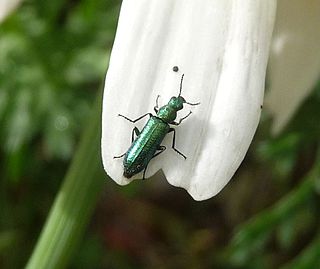
Psilothrix viridicoerulea is a species of soft-winged flower beetle belonging to the family Melyridae, subfamily Dasytinae.

Malachius bipustulatus, the malachite beetle, is a species of soft-winged flower beetles belonging to the family Melyridae, subfamily Malachiinae.

Chrysanthia viridissima is a species of beetles belonging to the family Oedemeridae subfamily Nacerdinae.

Miramella alpina, commonly known as the green mountain grasshopper, is a species of short-horned grasshopper in the family Acrididae.

Philaenus spumarius, the meadow froghopper or meadow spittlebug, is a species of insect belonging to the spittlebug family Aphrophoridae. In Italy and America, it is economically important as one of the vectors of Pierce's Disease .
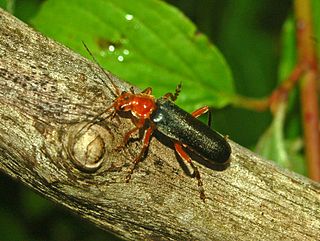
Cantharis livida is a species of soldier beetle belonging to the genus Cantharis family Cantharidae.
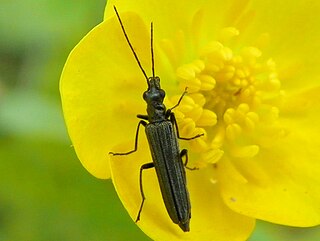
Oedemera lurida is a species of beetle belonging to the family Oedemeridae subfamily Oedemerinae.
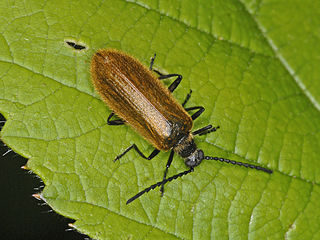
Lagria hirta is a species of beetles in the family Tenebrionidae.

Scelophysa trimeni, commonly known as the blue monkey beetle, is a species of scarab beetles in the tribe Hopliini, subfamily Melolonthinae.
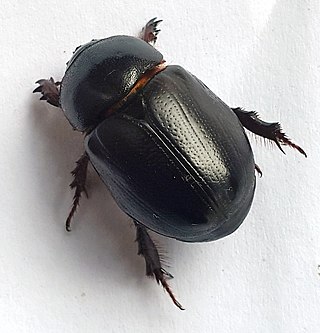
Heteronychus arator is a species of beetle in the subfamily Dynastinae. It is commonly called African black beetle or black lawn beetle. It is native to Africa and it is an introduced species in Australia, Norfolk Island and the North Island of New Zealand.

Phyllopertha horticola, the garden chafer or garden foliage beetle, is a beetle from the family Scarabaeidae. Phyllopertha horticola was described by Carl Linnaeus in his landmark 1758 10th edition of Systema Naturae.
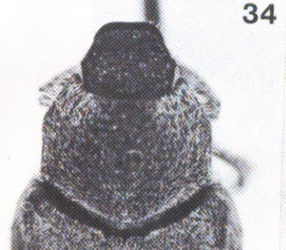
Hoplia callipyge is a species of scarab beetle in the family Scarabaeidae. It has been recorded in the western United States, in British Columbia in Canada, and in Baja California in Mexico. Adults are about 5.75–10.5 millimetres (0.226–0.413 in) long, 3.4–5 millimetres (0.13–0.20 in) wide, oval, and brown. They are very similar visually to other Hoplia species, especially Hoplia hirta and Hoplia laticollis.






















